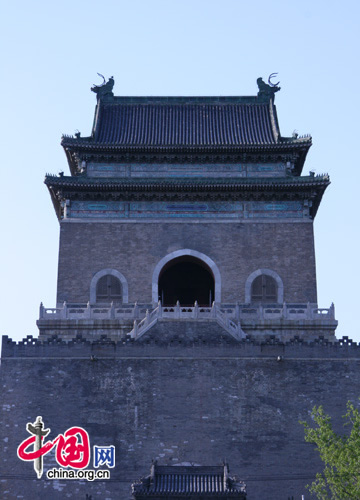'Untouchable' area of old Beijing under threat
|
Bell Tower [Ren Zhongxi/China.org.cn] |
One of Beijing's last remaining traditional neighborhoods could fall under the wrecker's ball as early as next month, China.org.cn has learned.
A local resident told reporters a senior district government official had informed him that demolition of traditional hutongs surrounding the capital's Drum and Bell Towers will begin in June.
The hutongs are to be cleared to make way for a controversial "Beijing Time Cultural City" development announced in January by the Dongcheng district government.
The 12-hectare project will feature public art celebrating the past timekeeping role of the Drum and Bell towers. There will also be a conference center and an underground area comprising parking lots, shops and a museum. In January, Dongcheng district mayor Yang Yiwen told Beijing Times the government was hoping to "attract international company HQs and international conferences."
It is thought residents displaced by the project will be relocated to Shunyi, a new town 30 kilometers east of Beijing.
The lead contractor is Beijing Oriental Culture Assets Operation Corporation – a state-owned company that has worked on several Beijing developments, including Hong Kong billionaire Li Ka-shing's 800,000 sq. m. Oriental Plaza.
Despite repeated calls, China.org.cn was not able to confirm the project start date with officials. Beijing Oriental said it is not authorized to release information. Li Yi from the Dongcheng media office said, "There is no more information about the project to tell the public." When asked if it would be possible to speak with Yang Yiwen, Li said the mayor was "not taking interviews," and "when she is ready to talk she will hold a press conference."
Conservationists had thought hutongs in the Drum and Bell Tower area were protected by cultural preservation orders and virtually untouchable. But the indications are that the district government intends to press ahead with the redevelopment.
There is no doubt the area has severe problems. Most of the hutong houses are dilapidated and overcrowded. Few have sanitary facilities; residents use public toilets and washrooms. Businesses have added incongruous extensions to traditional buildings. The wall of what was once a mosque now sports tacky bas-reliefs of the Terracotta Warriors.
But like many run-down inner city areas around the world, Gulou has become trendy. New boutiques, jewelry shops, bars and restaurants are springing up. Unfortunately, such gradual, slightly bohemian gentrification has little to offer a local government thirsty for revenue.
"Other districts have many big projects. We are envious, but we don't have the space," Yang Yiwen told Beijing Times in January.
By demolishing decaying high-maintenance housing and shifting a high-density population with its attendant high social costs, the government could turn a "loss-making" area into a revenue-generating asset through land sales, rent and business taxation.
 0
0 








Go to Forum >>0 Comments